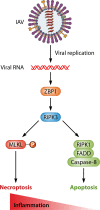Benefits and Perils of Necroptosis in Influenza Virus Infection
- PMID: 32051270
- PMCID: PMC7163144
- DOI: 10.1128/JVI.01101-19
Benefits and Perils of Necroptosis in Influenza Virus Infection
Abstract
Influenza A viruses (IAV) are lytic viruses that have recently been found to activate necroptosis in many of the cell types they infect. Necroptotic cell death is potently immunogenic and limits IAV spread by directly eliminating infected cells and by mobilizing both innate and adaptive immune responses. The benefits of necroptosis to the host, however, may sometimes be outweighed by the potentially deleterious hyperinflammatory consequences of activating this death modality in pulmonary and other tissues.
Keywords: MLKL; RIPK3; ZBP1; apoptosis; caspase-8; influenza; necroptosis.
Copyright © 2020 American Society for Microbiology.
Figures

References
-
- Laster SM, Wood JG, Gooding LR. 1988. Tumor necrosis factor can induce both apoptic and necrotic forms of cell lysis. J Immunol 141:2629–2634. - PubMed
Publication types
MeSH terms
Substances
Grants and funding
LinkOut - more resources
Full Text Sources
Medical
Miscellaneous

